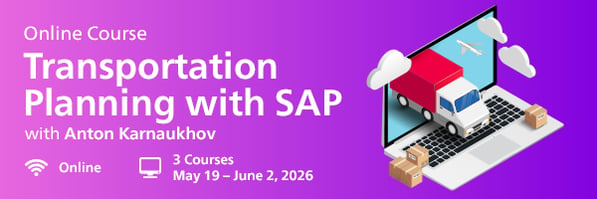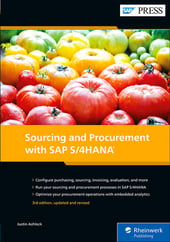Nowadays, many companies are undergoing mergers or acquisitions. SAP can help streamline the logistics of transferring goods between newly aligned companies using a standard process called intercompany stock transport orders.
In this blog post, we’ll discuss the main steps to be completed in an SAP system for intercompany stock transport order (ISTO) processes.
Like in my previous post on stock transport orders, I’ll provide instructions on an SAP ECC 6.0 system. However, it is relevant for other versions of SAP as well. I have implemented the MM, SD, and LE-SHP modules in my system.
There are a number of advantages to transferring stock with ISTO, including:
- A goods receipt can be planned in the receiving plant.
- You can specify a freight vendor in the ISTO document.
- Delivery costs can be entered into the ISTO.
- Purchase requisitions created in MRP can be converted into ISTOs.
- Availability checks can be run in the system for ISTOs.
- You can post a goods issue for the STO in either MM-IM or LE-SHP. For the goods issue in SD, a replenishment delivery is created.
- The goods receipt can be posted directly to consumption with reference to inbound deliveries.
- The process can be monitored via purchase order history and standard reports.
Business Activities in SAP
The figure below displays the steps to be done in the system.

Transactional Data
In order to create an ISTO, the purchasing department will use transaction ME21N or this menu path: Logistics > Materials Management > Purchasing > Purchase Order > Create > Vendor/Supplying Plant Known.
In the next figure, you can see the main details of this document and, in particular, that the ISTO has been created to order goods from plant 0002 which belongs to company 1000, to plant 0003 which belongs to company 2000.

Outbound Delivery Creation
In order to create the outbound delivery with reference to the ISTO created in the previous step, you can use transaction VL10B or follow this menu path: Logistics > Logistics Execution > Outbound Process > Goods Issue for Outbound Delivery > Outbound Delivery > Create > Collective Processing of Documents Due for Delivery > Purchase Orders.
In the following figure, you can see the main selection criteria used to run that report.

The system will display that PO#4500000008 could be processed. Select this line item and save the posting. The system will create the delivery in the background and provide the following information message.

In order to display the outbound delivery document that was created, you can use transaction VL03N or follow this menu path: Logistics > Sales and Distribution > Shipping and Transportation > Outbound Delivery > Display.
In this figure, you can see the main details of the delivery created in the previous step.

Check the Stock Level in the Issuing Plant
In order to check the stock level in the issuing plant, you can use transaction MMBE or follow this menu path: Logistics > Materials Management > Inventory Management > Environment > Stock > Stock Overview.
After entering the appropriate selection values and running the report, the system will show the details as listed in this figure.

Pick and Goods Issue Posting
In order to pick and post the goods issue in the sending plant, without using LEWM, you can use transaction VL02N or follow this menu path: Logistics > Logistics Execution > Outbound Process > Goods Issue for Outbound Delivery > Outbound Delivery > Change.
Specify the picked quantity in the picking tab, and choose the option “Post Goods Issue,” as shown in this figure.

Note that after the goods issue has been posted, the stock overview displays the quantity transferred as Stock in trans. CC; this detail will be visible using standard SAP reports, for example transaction MMBE, or double-clicking on the company code material stock’s segment.
- This stock is determined dynamically for stock balance display.
- With the transfer posting, price determination is carried out in both purchasing and SD.
- In purchasing, the price of the material in question is determined in the usual manner (from the info record, for example).
- In SD, pricing is also carried out as normal during the billing process.
- The goods movements are valuated at the price determined in each case.
Tip: In order to check the stock in transit from plant 0001 to 0003, you can use transaction MB5T or follow this menu path: Logistics > Materials Management > Inventory Management > Environment > Stock > Stock in Transit (Company Code).
Display the Goods Issue Material Document
In order to display the material document created by activities done in the previous steps, follow this menu path: Logistics > Materials Management > Inventory Management > Goods Movement > Goods Movement, or use transaction MIGO.
In the figure below, note the following details:
- In the standard system, the MvT to post the GI, in case of cross company code, is 643.
- The delivery note field contains the number of the outbound delivery.
- In the purchase order tab, you can find the PO# that has been used for the process.

Check the Stock Level at the Issuing Plant
In order to check that the stock level in the issuing plant has been decreased by 1kg, you can use transaction MMBE or follow this menu path: Logistics > Materials Management > Inventory Management > Environment > Stock > Stock Overview. After entering the appropriate selection values and running the report, the system will show the details as listed in this figure.

Check the Stock Level in the Receiving Plant
In order to check the stock level in the receiving plant, you can use transaction MMBE or follow this menu path: Logistics > Materials Management > Inventory Management > Environment > Stock > Stock Overview. After entering the appropriate selection values and running the report, the system will show the details as listed in this figure.

Post the Goods Receipt in the Receiving Plant
In order to post the goods receipt in the receiving plant, you can use transaction MIGO or follow this menu path: Logistics > Materials Management > Inventory Management > Goods Movement > Goods Movement.
In the next figure, you can see the main details of the goods receipt material document, and the document number that was created automatically by the system.

Tip: Note that in this case, I processed the goods receipt with reference to the outbound delivery document but, usually, the company needs an inbound delivery. In such cases, this document can be created either manually or automatically based on the PGI posted in the sending plant via output type “SPED.” To reverse these postings, you can use the output type “SPER.” The document flows will be updated accordingly.
Post the Logistics Invoice Verification in the Receiving Plant
To post the logistic invoice verification (LIV) in the receiving plant, the accounts payable department can use transaction MIRO or follow this menu path: Logistics > Materials Management > Logistics Invoice Verification > Document Entry > Enter Invoice.
In this figure, you can see the main details of the LIV material document and the document number that was created automatically by the system.

Display ISTO History
In order to display the ISTO history, you can use transaction ME23N or follow this menu path: Logistics > Materials Management > Purchasing > Purchase Order > Display. Then display the details of the PO history tab.
In the following figure, you can see the documents created with reference to the ISTO.

Check the Stock Level at the Receiving Plant
In order to check that the stock level in the receiving plant has been increased by 1kg, you can use transaction MMBE or follow this menu path: Logistics > Materials Management > Inventory Management > Environment > Stock > Stock Overview.
After entering the appropriate selection values and running the report, the system will show the details as listed in this figure.

Create a Billing Document
In the intercompany scenario, there are two billing documents: one from the ordering company to the customer, and another from the supplying company to the ordering company (an internal customer).
To create the billing document, the accounts receivable department can use transaction VF01 or follow this menu path: Logistics > Sales and Distribution > Billing > Billing Document > Create. Then enter the data as shown in this figure.

After specifying the data shown in the previous screen, pressing enter, and saving, the system will create the billing logistics and accounting documents.
In order to display those documents, you can use transaction VF03.
In this case, the system will provide the following details.

To check the pricing details, the user can select the billing line item and choose the option: Go to > Item > Item Conditions. The system will provide the following details.

Note the following:
- Price condition PR00 has been disabled by condition IV01.
- The value of price condition IV01 represents the intercompany price.
- The value of condition VPRS represents the internal company’s price (in this case there is no profit).
To display the billing accounting document details, the user can select the accounting option. The system will provide the following details.

Check the Document Flow for the Outbound Delivery
To display the history of the outbound delivery, use transaction VL03 or follow this menu path: Logistics > Logistics Execution > Outbound Process > Goods Issue for Outbound Delivery > Outbound Delivery > Display. Specify the outbound delivery document number and choose the option document flow; the system will provide the following information.

Tip: The intercompany billing accounting document has the status “not cleared” as the payment run has not yet been made. To register payment from the customer, the treasury department can use transaction F110 or follow this menu path: Accounting > Financial Accounting > Accounts Receivable > Periodic Processing. Usually, it is scheduled in the background.
Note: In accounting, intercompany transfer pricing is the price charged for goods or services exchanged between companies within the same group of companies. The purpose of transfer pricing is to ensure that each company in a group contributes fairly to the overall profitability of the group. Imagine a scenario where Company A sells fabric to its manufacturing entity in a low-tax country, Company B. Accountants record the transfer price as a revenue of the producing segment and as a cost, or expense, of the receiving segment. Usually, no cash changes hands between the segments. Instead, the transfer price is an internal accounting transaction.
The most used methods for transfer pricing are the following:
- Comparable uncontrolled price (CUP) method. The CUP method is grouped by the OECD as a traditional transaction method (as opposed to a transactional profit method).
- Resale price method
- Cost plus method
- Transactional net margin method (TNMM)
- Transactional profit split method
Eliminating intercompany transactions is an important accounting function that ensures accuracy in the business's financial statements. Intercompany transactions can artificially inflate profits and liabilities in the business, which leads to inaccurate financial statements.
If the process is not robust enough, you could face issues, like the following:
- Unreliable financial reporting
- Discrepancies in financial statements: misstating revenue, costs, and balances
- Misallocation of resources
- Loss of revenue and profit
- Compliance issues
The financial department must create a clear process that is in line with local regulations and company policies.
Master Data
The master data management department, via transaction MM01, should maintain the material master as follows. For the supplying plant, the following views must exist:
- Basic views
- Sales views (in particular shipping data like the item category group, loading group, transportation group, and availability check)
- Inventory views
- Accounting views
For the receiving plant, the following views must exist:
- Basic views
- Purchasing views
- Inventory views
- Accounting views
The vendor master record must be created for the issuing plant. The issuing plant code should be linked to the vendor master in the purchasing view, using the purchasing organization specified in the ISTO document. This can be done either via transaction XK01 in SAP ECC or via business partners in SAP S/4HANA.
The customer master record must be created for the receiving plant. From this, both the address and other data that is relevant for shipping, such as transportation zone and shipping condition, are considered during the transactional processes.
For the intracompany code stock transport, it is sufficient to create the customer master record as a goods recipient for the appropriate organizational units. This can be done either via transaction XD01 in SAP ECC or via business partners SAP S/4HANA.
The price conditions must be created for “PR00 – Price,” usually maintained using organizational elements of the ordering company code, end customer, the material, and the “PI01 – Intercompany Price” condition type to represent costs to the ordering company code (in other words, revenue to the supplying company code). Its statistical condition type is meant for informational purposes only.
Condition records for PI01, usually, are created with the following combination: ordering sales organization, supplying plant, and material. This can be done via transaction VK11.
Customizing
In SD, there are a number of relevant customizing steps you can do. They’re listed below.
- Defining the technical sales order type via transaction VOV8.
- Defining order types for intercompany billing in SPRO.
- Assigning the appropriate sales area to plants in SPRO.
- Defining the internal customer number by sales organization in SPRO.
- Maintaining the main price procedures for the intercompany processes via transaction V/08.
- RVAA01 Standard Price Procedure (for customer transactions): In the standard system, when the ordering company raises a billing document with pricing procedure RVAA01, condition PI01 represents the cost of the ordering company. Pricing procedure RVAA01 represents condition type PR00 and any other discounts or surcharges that are relevant to the end customers.
- ICAA01 Intercompany Price Procedure (for internal customer transactions): When the supplying company raises a bill to the ordering company, condition type IV01 shows the revenue of the supplying company, which is part of the pricing procedure ICAA01, and assigned to intercompany billing document IV.
- Maintain price procedures determination via transaction OVKK.
- You need to assign pricing procedure RVAA01 to the combination of sales area (of the ordering company code), customer pricing procedure, and document pricing procedure of the sales document type.
- Pricing Procedure ICAA01 – Pricing Procedure for intercompany billing is assigned to the combination of the sales area (of the supplying company code), document pricing procedure of billing document type IV, and the customer pricing procedure of the Internal customer.
For shipping, there are some additional customizations you can do.
- Maintaining shipping points for the delivery plants.
- Assigning shipping points via transaction OVXC.
- Depending on the supplying plant, you can add the shipping condition of the customer master record belonging to the receiving plant, and the loading group of the material.
- Determining the shipping point via transaction OVL2.
- This customizing step is necessary to determine the shipping point during outbound delivery creation. You must enter a shipping point using a combination of any of the following:
- Shipping condition from the customer master record of the ordering plant
- Loading group from the material master
- Supplying plant
- Displaying the details of the outbound delivery document type NLCC via transaction 0VLK.
- Displaying the details of the outbound delivery item category via transaction 0VLP.
- Determining the appropriate item category during outbound delivery creation via transaction 0184.
- Defining the copying control for delivery via transaction VTLA.
Conclusion
This blog post gave an overview about the process to be followed in order to transfer goods from one SAP plant to another in cases where they belong to different legal entities.
Learn Transportation Planning in Our Upcoming Rheinwerk Course!
Get the most out of your SAP TM system! Unlock the intricacies of transportation planning logic, system behavior, configuration levers, and best practices for real-world logistics operations. True planning proficiency is within reach—and with this course, SAP TM mastermind Anton Karnaukhov hands you the keys. Click on the banner below to learn more and order your ticket.
This post was originally published 8/2024.





Comments